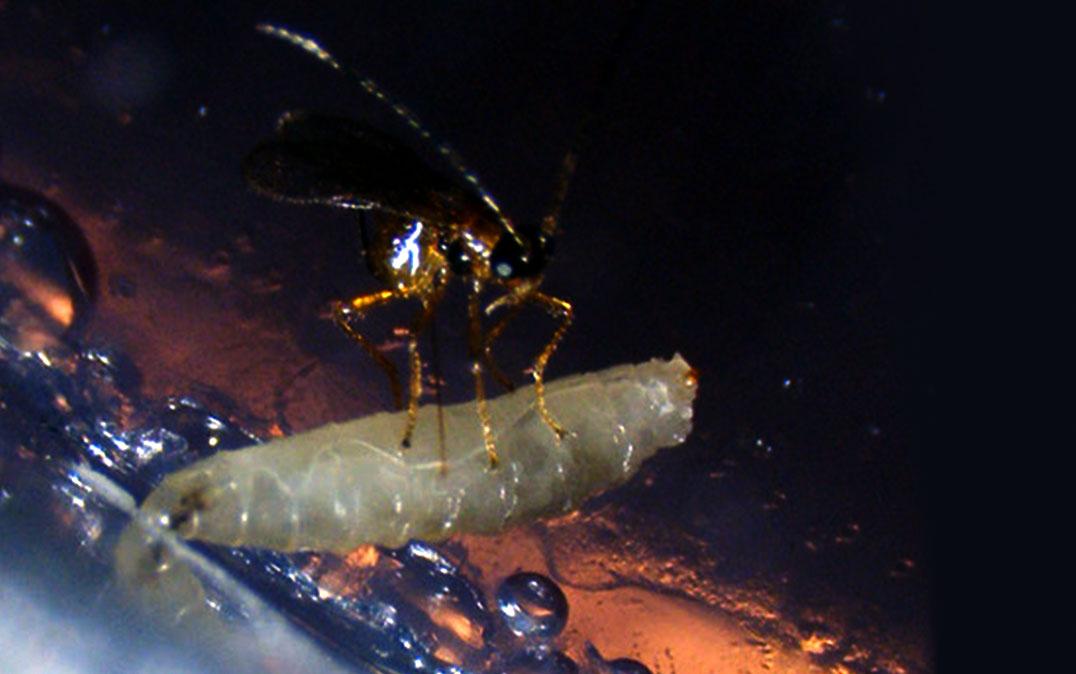Research News
Can a Parasitic Wasp Save Your Fruit Crops?

Researchers from the University of Tsukuba develop a genetic toolkit for investigating the molecular mechanisms carried out by parasitic organisms in their hosts
Tsukuba, Japan—The wasp species Asobara japonica (A. japonica) is a parasitic organism, meaning it sustains its life by hijacking resources from a host such as the fruit fly Drosophila melanogaster. The wasp mother can secrete a venom full of toxic components that overcome the host's immune defenses to enable its baby wasp to live inside the host. In a newly published article in DNA Research, a team led by researchers at the University of Tsukuba used various molecular biology techniques to devise a protocol for gene knock-down in the wasp, investigating the specific mechanistic details of this parasitism.
The fascinating parasitic nature of A. japonica may have economic utility for humans. A. japonica can also parasitize Drosophila suzukii, another fly species that often negatively affects fruit crops. Other parasitic species have previously been used to manage such pests. To utilize A. japonica in a similar manner, the University of Tsukuba team sought to examine the molecular mechanisms that fuel its parasitic success to aid in developing a more optimal strategy.
Using a clonal strain of A. japonica and whole-genome sequencing (WGS) procedures, the team sequenced and analyzed the wasp's full DNA code. They also performed RNA-sequencing analysis to predict a whole set of 12,508 genes in the wasp.
"Based on the data from the WGS and RNA-sequencing analyses, we identified a wasp gene called ebony that is the DNA code for an enzyme known as N-β-alanyl dopamine (NBAD) synthetase," explains primary author Takumi Kamiyama. Primary co-author Yuko Shimada-Niwa describes the responsibility of this enzyme for converting dopamine molecules to NBAD, adding that "the loss of its function affects melanin levels and results in a dark body color."
The team then used a technique called RNA interference (RNAi) which introduces a synthetic RNA molecule that targets specific RNA messages within a cell and reduces expression of that gene. Here, the ebony gene was targeted and was found to cause body color changes in A. japonica, confirming that RNAi could be successfully implemented in the wasps.
The sequencing data also helped the researchers identify the group of genes likely involved in venom production, because they were predominantly expressed in the venom gland. The RNAi technique also helped them determine that venom gene expression could be suppressed.
Overall, this work sets the stage for future studies by developing an effective set of methods for examining the venom mechanisms in A. japonica. Reducing venom gene expression with RNAi may lead to phenotypic and molecular changes that could help elucidate the functions of these genes. This will provide important information for the development of this parasitic species into an insecticide strategy.
Original Paper
The article, "Whole-genome sequencing analysis and protocol for RNA interference of the endoparasitoid wasp Asobara japonica," was published in DNA Research at DOI: 10.1093/dnares/dsac019
Correspondence
Assistant Professor SHIMADA-NIWA YukoLife Science Center for Survival Dynamics, Tsukuba Advanced Research Alliance (TARA), University of Tsukuba
Related Link
Life Science Center for Survival Dynamics, Tsukuba Advanced Research Alliance (TARA)
PREVIOUS
A Light Twist




